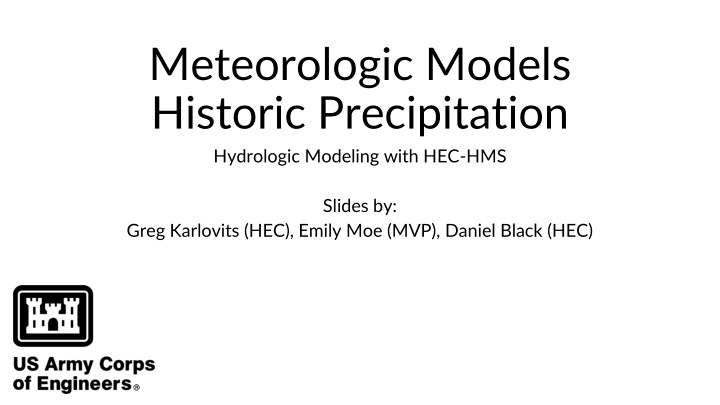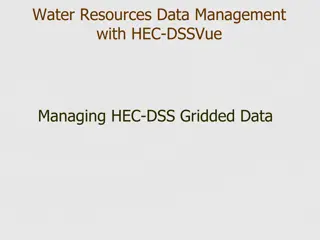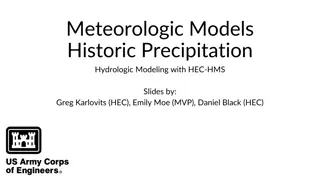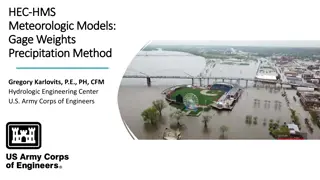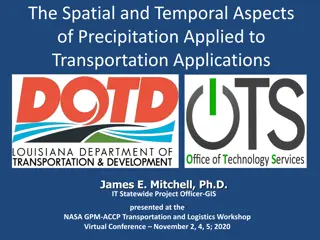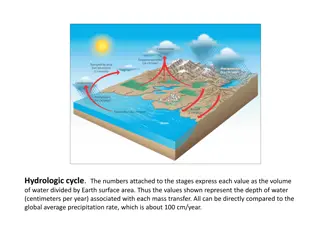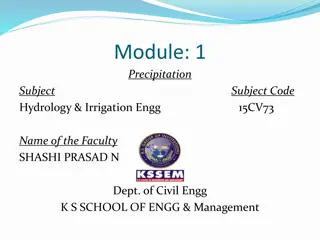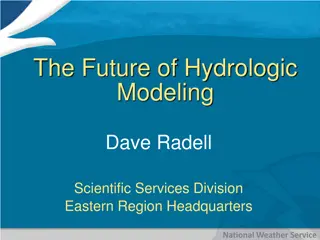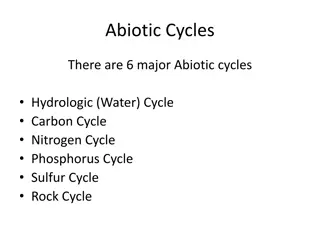Hydrologic Modeling with Gridded Precipitation Data
Learn about utilizing gridded precipitation data for hydrologic modeling with HEC-HMS. Explore the advantages of spatially distributed precipitation sources such as RADAR and gauge comparisons, and understand the various national and regional products available. Discover utilities for converting and creating precipitation gridsets, including gageInterp for transforming observation points into grids. Gain insights into defining DSS pathnames for grids in HEC-HMS and the importance of accurate grid type specifications for precipitation, temperature, solar radiation, crop coefficients, storage capacity, percolation rates, and more.
Download Presentation

Please find below an Image/Link to download the presentation.
The content on the website is provided AS IS for your information and personal use only. It may not be sold, licensed, or shared on other websites without obtaining consent from the author.If you encounter any issues during the download, it is possible that the publisher has removed the file from their server.
You are allowed to download the files provided on this website for personal or commercial use, subject to the condition that they are used lawfully. All files are the property of their respective owners.
The content on the website is provided AS IS for your information and personal use only. It may not be sold, licensed, or shared on other websites without obtaining consent from the author.
E N D
Presentation Transcript
Meteorologic Models Historic Precipitation Hydrologic Modeling with HEC-HMS Slides by: Greg Karlovits (HEC), Emily Moe (MVP), Daniel Black (HEC)
Gridded Precipitation Pros Spatially distributes precipitation Ex: RADAR vs. precip gage Increasing number of sources available National & Local Availability Cons May require conversion Quality of data varies Quality control recommended Gage comparison RADAR coverage
Gridded Precipitation Sources National Products National Digital Guidance Database (NDGD) (2007-Present) Regional Products NWS River Forecast Centers NEXRAD CWMS USACE Water Management data Add l Other Products
Converting & Creating Precipitation Gridsets Utilities available: 1. HMS certain file types can be imported directly within HMS 2. VORTEX converts several formats to HEC- DSS Records NetCDF, Grib, HDF, ASC & more Also allows for clipping, re- projecting, resampling, etc. 3. gageInterp creates a grid by interpolating point values
Creating Precipitation Gridsets from Point Data gageInterp Converts observation points to grids
Gridded Precipitation DSS Pathnames for Grids in HEC-HMS /A-part/B-part/C-part/D-part/E-part/F-part/ A grid system (SHG, HRAP) B region or watershed name C the data variable (precip, temp, ) D starting time for grid (ex: 04JAN2021:1500) E ending time for grid (ex: 04JAN2021:1600) F additional identification (e.g. obs, radar, NWS, )
Gridded Precipitation Grid Type Precipitation Temperature C-Part PRECIPITATION Units MM, IN DEG C DEG F WATT/M2 LANGLEY/M IN Data Type PER-CUM PER-AVER INST-VAL TEMPERATURE Grids must have: Correct C-part pathname Correct units Valid Data type Values for each grid cell Solar Radiation PER-AVER INST-VAL SOLAR RADIATION Crop Coefficient PER-AVER INST-VAL INST-VAL CROP COEFFICIENT UNSPECIF Storage Capacity Percolation Rate STORAGE CAPACITY MM, IN MM/HR IN/HR PERCOLATION INST-VAL Storage Coefficient STORAGE COEFFICIENT MOISTURE DEFICIT IMPERVIOUS AREA CURVE NUMBER ELEVATION COLD CONTENT HR INST-VAL Moisture Deficit Impervious Area SCS Curve Number Elevation Cold Content Cold Content ATI MM, IN % UNSPECIF M, FT MM, IN DEG C DEG F DEGC-DAY DEGF-DAY MM, IN INST-VAL INST-VAL INST-VAL INST-VAL INST-VAL COLD CONTENT ATI INST-VAL Meltrate ATI MELTRATE ATI INST-VAL Liquid Water Snow Water Equivalent LIQUID WATER INST-VAL SWE MM, IN INST-VAL
Defining Discretization Required to run HMS with gridded components Spatially relates gridded datasets to subbasins Specified by Subbasin Four Discretization Methods: 1. Structured 2. Unstructured 3. File-Specified 4. None
Defining Discretization Four Discretization Methods: 1. Structured* Automatic Method Defaults to standard SHG grid & 2- km cell size 2. Unstructured Any coord. System Allows unstructured grid such as RAS plan files (ex: *.p##.hdf) 3. File-Specified Points to HEC-HMS Grid Cell Files (*.mod) 4. None Lumped-Parameter No variation within subbasin
Meteorologic Models Historic Precipitation Hydrologic Modeling with HEC-HMS
